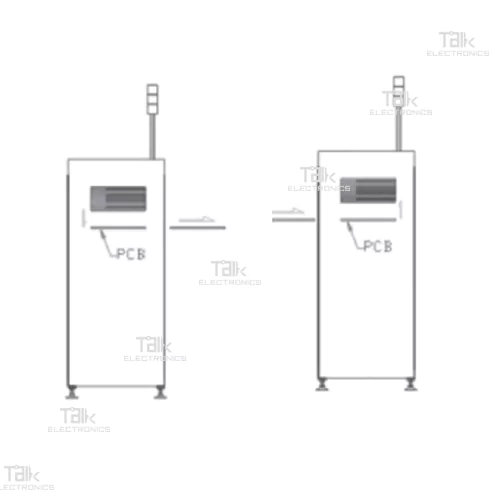Understanding PCB Stacker Destackers
PCBs form the backbone of electronics manufacturing. PCBs get stacked between production processes for temporary storage and move sequencing. Manually stacking and destacking PCBs creates bottlenecks. PCB stacker destackers automate these tasks for faster material flow.
PCB stacker destackers are automated systems designed to:
Neatly stack and organize multiple PCBs after processing stages.
Securely pick up single PCBs from stacks for transfer to next process.
This eliminates manual stacking/destacking, improving efficiency, reducing damage, and optimizing workflow.
Types of PCB Stacker Destackers
Pick-and-Place:
Robotic arms to dynamically stack and destack.
Conveyor-Based:
Conveyors and grippers for stacking and destacking.
Cartesian:
Gantry system with gripper to manipulate PCB stacks.
Pallet-Based:
Stacks and destacks PCBs on movable pallets.
Key Components
Stacking Mechanism:
Aligns and methodically stacks PCBs.
Destacking Mechanism:
Grips and picks single PCBs from stacks.
Conveyors:
Transport PCBs between equipment.
Actuators:
Provides motion for manipulation.
Controls:
Enables preset configuration of handling parameters.
Sensors:
Detects PCB positioning to guide automation.
Benefits of PCB Stacker Destackers
Increased Efficiency:
Automated handling is faster than manual processes.
Streamlined Workflow:
Smoother material movement between processes.
Damage Reduction:
Secure and consistent PCB handling minimizes errors.
Smaller Footprint:
Compact systems take up minimal floor space.
Labor Savings:
Require less direct human involvement for stacking.
Easy Integration:
Interfaces allow syncing stackers/destackers with other equipment.
Flexibility:
Some models allow dynamic on-the-fly stacking configurations.
Best Practices for PCB Stacker Destacker Operation
Perform regular preventive maintenance and calibration
Adjust handling settings appropriately for different PCBs
Position equipment appropriately within the assembly line
Implement proper guidelines for safe equipment operation
Train employees thoroughly on loading and unloading
Institute measures to prevent overloading or mishandling
Follow manufacturer’s instructions for resolving faults or jams
Selecting the Right PCB Stacker Destacker
Key selection criteria:
Required throughput and PCB volume needs
PCB dimensions and fragility
Types of PCBs to be handled
Available floor space constraints
Integration requirements with existing equipment
Options for expandability and automation
Budget constraints
Careful assessment of requirements ensures optimal selection.
Maximizing Productivity and Utilization
Strategies to optimize PCB stacker/destacker productivity:
Position equipment appropriately within the material flow.
Design efficient staging and movement patterns.
Leverage automation capabilities for 24/7 operation.
Perform proactive planned maintenance procedures.
Continuously monitor and analyze performance data.
Identify and address any bottlenecks limiting throughput.
Train personnel thoroughly on proper operation.
Every percentage gain in utilization results in major productivity gains.
Common Challenges and Solutions
PCB jamming:
Check for obstructions; adjust gripper pressure as needed.
Stack misalignment:
Re-calibrate sensors; inspect component wear.
Picking/placing errors:
Adjust vacuum pressure; check gripper condition.
Mechanical issues:
Lubricate or replace worn parts like bearings.
Control malfunctions:
Restart controller; check connections; upgrade software.
Conveyor damage:
Inspect belts for wear/cracks; replace damaged belts.
Promptly addressing any problems is vital for maximizing uptime.
Safety Measures and Precautions
PCB stacker/destackers can potentially pose safety risks like:
Getting body parts caught in machine
Impact hazards from moving equipment
Electrical hazards during maintenance
To minimize risks:
Install safety guards and interlocks
Ensure easily accessible emergency stop buttons
Provide applicable safety training to personnel
Follow lockout/tagout procedures during maintenance
Post caution signs on or near equipment
Future Trends and Outlook
Key trends shaping PCB stacker/destacker evolution:
Smarter machines with IIoT connectivity and data capabilities
More advanced vision systems for dynamic automation
Adoption of collaborative robots for flexible stacking
Modular and reconfigurable designs
Integration with other emerging technologies like AGVs and automated warehouses
These innovations will further optimize PCB material handling in smart factories.
Economic Impact
PCB stacker/destackers deliver tangible economic benefits:
Reduced direct labor costs
Faster assembly line throughput
Minimized PCB damage resulting in less waste
Smaller machine footprint reduces factory space needed
These benefits translate into major cost savings and productivity gains.
Case Studies
Company A implemented robotic PCB stackers and destackers, improving line throughput by 25% and reducing stack handling labor by 30%.
Company B’s conveyor-based stacker/destacker system helped increase output by 20% and paid back its capital investment in under 9 months.
Company C cites PCB stacker/destackers as crucial for scaling up manufacturing without expanding plant size.
Frequently Asked Questions
Q: What are the main benefits of PCB stacker destackers?
A: They automate stacking/destacking for faster material flow, reduced labor, and minimized errors.
Q: Can these machines handle different PCB sizes?
A: Many models allow easy adjustment to accommodate small or large PCBs.
Q: Are stacker/destackers suitable for high-volume PCB production?
A: Yes, they provide the fast handling needed for high-volume manufacturing.
Q: How do they improve assembly line productivity?
A: Automated handling eliminates bottlenecks associated with manual stacking/destacking.
Q: What safety precautions do they incorporate?
A: Safety features include interlocks, E-stops, guards, and compliance with standards.
Q: What maintenance do they require?
A: Routine inspections, lubrication, calibration, and replacement of worn parts as needed.
Q: Is personnel training recommended?
A: Yes, proper training helps maximize operational productivity and safety.
Q: Can they handle multi-layer or delicate PCBs?
A: Yes, adjustable handling settings prevent damage to fragile components or boards.
Solving the PCBA industry biggest problems
Working with ElectronicsTalk offers you high-standard PCBA products that are supplied from credible manufacturers in attractive cost.
We dedicate to provide the best customer support, its the vital aspect of our company philosophy.



